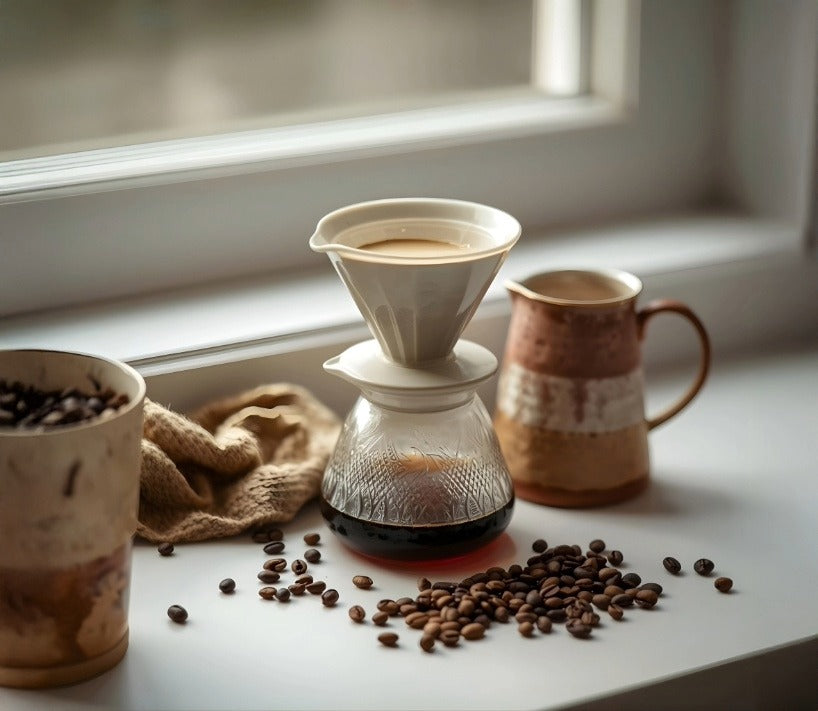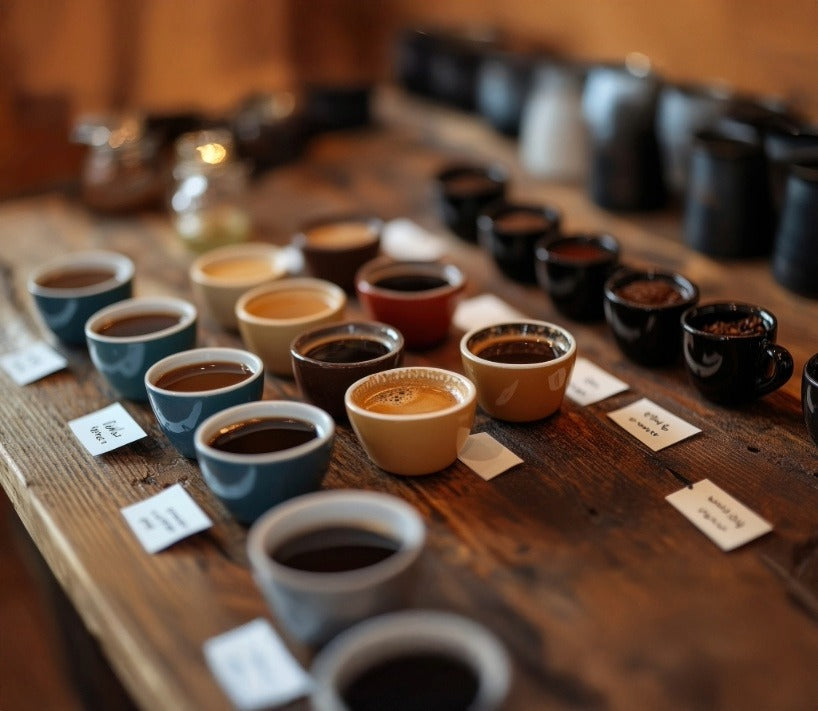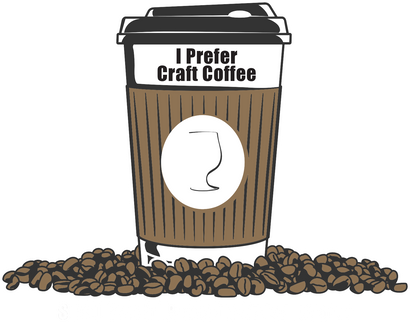Best Coffee To Buy Online Is Fresh
May 08, 2025 4 min read
Fresh Is Best: How to Know When Your Coffee Beans Are Still Kickin’ (and When They’ve Kicked the Bucket)
It’s 7 a.m., the alarm is screaming, and you shuffle to the kitchen ready for salvation in a mug. You scoop, grind, brew…and blah—your cup tastes like cardboard did a backflip into lukewarm brown water. Before blaming the brewer (or your half‑awake barista skills), consider the silent culprit: stale beans.
I’ve been there—hunting for the best coffee to buy online, filling my shelves with shiny bags, only to discover they hid the flavor excitement of a damp sock. So let’s pull back the curtain on freshness, roast dates, and why some beans feel livelier than a karaoke bar at midnight while others seem DOA.
1. Coffee Is Produce—Not a Paperweight
We treat coffee like dry goods because it looks shelf‑stable, but inside each bean are delicate oils and sugars that break down quickly once roasted. Think of it as fruit in disguise: gorgeous on day one, meh by week four, and a compost candidate by week eight.
-
Degassing & CO₂ Party – Right after roasting, beans release carbon dioxide, which acts like flavor armor. Around day 7–10, that gas calms down, letting water extract those sweet, chocolaty notes we adore.
-
Oxidation Sneaks In – Oxygen loves to crash the party, turning vibrant flavors flat. Light, heat, and moisture pile on, speeding the decline.
Peak window? For most specialty roasts—especially the best small batch coffee and best espresso beans—flavor sweet‑spots hover between days 7 and 21 post‑roast. After that, intensity tapers off faster than your New Year’s gym routine.
2. Roast Date vs. “Best By”: Read the Fine Print
Some brands stamp “Best By” dates six months (or a year!) out. Spoiler alert: that’s warehouse convenience, not flavor science. If a bag shouts best craft coffee online yet hides the roast date, treat it like a mystery meat taco—proceed with caution.
What to look for on the label:
-
Clear Roast Date — Day / Month / Year printed loud and proud.
-
Small Batches Listed — Indicates frequent roasting runs, not Costco‑sized pallets marinating in storage.
-
Valve Bags — One‑way degassing valves keep CO₂ in and oxygen out, preserving those aromatics that make the best tasting whole bean coffee pop.
3. Quick At‑Home Freshness Tests
Can’t find a date? Try these MacGyver moves before writing the beans off:
-
Smell Test – Fresh beans hit you with sweet aromatics: berries, cocoa, or toasted nuts. If it smells like cardboard or dusty attic, stale alert.
-
Bloom Check – For pour‑over fans: pour a splash of hot water over the grounds. Fresh coffee bubbles and expands (that’s CO₂ escaping). No bloom, no boom.
-
Oily Sheen – Dark roasts develop a light oil film over time. If an oil slick covers the beans while the roast date is MIA, chances are they’re old and stressed.
-
Taste Reality – Brew a cup black (it’s a good coffee to drink black test). If it tastes sour, papery, or hollow, you’ve met Old Man Stale.
4. Proper Storage: Be the Bean Bodyguard
You scored a fresh bag—nice! Now keep it that way:
-
Airtight Containers – Choose opaque, vacuum‑sealing canisters for the win.
-
Cool, Dry, Dark – Countertop away from sunlight, stove heat, or that steamy dishwasher vent.
-
Freeze—But Correctly – Only if you must. Freeze in small one‑week portions, airtight. Thaw once, use promptly. Re‑freezing invites moisture and burns flavor.
-
Grind on Demand – Pre‑ground coffee stales in hours. Invest in a burr grinder; your morning self will send you thank‑you notes.
5. FAQs Your Barista Wishes You’d Ask
| Question | Fast Answer |
|---|---|
| Can old coffee make me sick? | Unlikely—it’s just flavor flat. |
| Is light roast fresher longer than dark? | Light can keep nuance slightly longer, but all roasts fade past three weeks. |
| Do vacuum‑sealed bricks from the grocery store count? | They’re roasted months ago; great for emergency caffeine, lousy for peak flavor. |
| If I’m gifting coffee beans as a gift, how close to roast should they be? | 7–10 days before hand‑off: flavor at prime, still degassed enough for any brewer. |
Your 5‑Step Freshness Cheat Sheet
-
Hunt the Roast Date – No date, no deal.
-
Buy Smaller, More Often – Skip bulk bargains; think 12–16 oz at a time.
-
Store Like a Pro – Airtight, cool, grind right before brewing.
-
Use or Lose – Brew within three weeks for peak flavor fireworks.
-
Still Unsure? Ask Me! – Drop a comment, DM, carrier pigeon—whatever. I geek out on freshness questions, even if you’re “just browsing.”
Parting Sip
Whether you search “where can I buy fresh coffee beans near me,” chase the top coffee delivered to your door, or simply crave the best craft coffee at home, freshness is the make‑or‑break factor. Ignore flashy packaging; focus on the humble roast date like your flavor future depends on it—because it does.
And if somewhere down the caffeine rabbit hole you get confused, wave a flag. I’m always up for a coffee convo—zero strings attached, no secret sales pitch. Let’s decode dates, compare bloom selfies, or chat storage hacks. Because life is too short (and mornings too precious) for stale coffee.
Stay fresh, keep sipping, and I’ll see you in the comments—preferably before the beans get old.
Also in Best Coffee To Buy Online Education

Third Wave Coffee Beans Home: What Makes Them Better?
December 21, 2025 4 min read
Several years ago, I didn't know what Third Wave Coffee was, and now I run a tiny micro-roastery built around fresh roasted coffee beans online, single origin clarity, and roast to order coffee. If you want the best tasting craft coffee at home, order coffee online from a roaster who focuses on Third Wave Coffee.

Best Specialty Coffee Explained: Why It Tastes So Much Better
December 20, 2025 5 min read
Learn why the best tasting specialty coffee at home tastes sweeter, cleaner, and better — and how to pick the best beans for home brewing. Taste the difference when you order coffee online through I Prefer Craft Coffee.

What Makes Specialty Coffee Taste Better: The Real Reason
December 19, 2025 4 min read
I’ve also roasted thousands of pounds of air roasted coffee beans, shipped fresh roasted coffee beans online, and helped tons of people upgrade from “meh” to “HOLY FLAVOR” with tiny changes.
